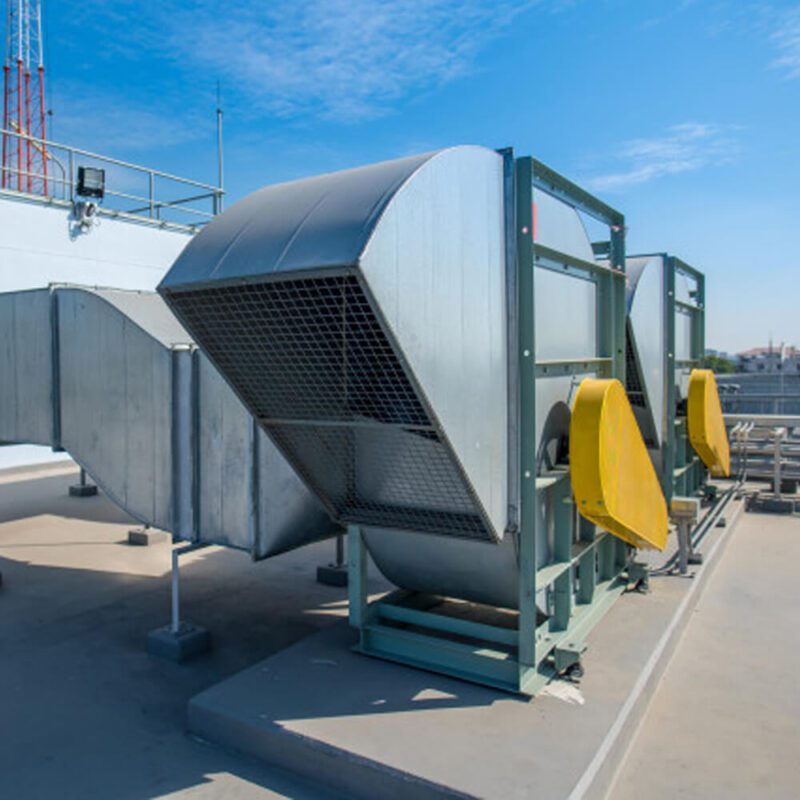Recommendations for ventilation of industrial buildings

BLOG
Recommendations for ventilation of industrial buildings
Industrial buildings are characterized by their large dimensions, these can be adapted to the distribution needs and required space. Another important aspect is that they must have ventilation systems in addition to the natural ones. In most cases, industrial buildings already have ventilation systems, but they are obsolete and do not work properly and in others they do not even exist.
Industrial ventilation in 2021
Air quality has always been a very important factor inside industrial buildings, during 2020 this issue became more relevant, protecting the Health of employees around the world became a priority, due to the Sars-Cov issue. -2 (Covid19), the measures taken by companies became much stricter, raising the standards of ventilation systems for air filtering. Industrial buildings in which workers stay during their working hours must keep the air they breathe completely clean, free of viruses and bacteria, in addition to any other harmful agents such as dust, fumes, mists, gases, among others.
As additional data, respiratory diseases are one of the main causes of absenteeism from work, in Mexico during 2019 more than 24 million Mexicans suffered some type of respiratory infection, where adults between 24 and 45 years of age stand out. Another consequence of not having a comfortable and virus-free work environment is that employees can become irritated, stressed, or distracted from their activities, causing accidents.
But, how does the ventilation system of an industrial building work?
The ventilation of an industrial building is defined as the way to renew or clean the air inside it, through a system that allows to extract contaminated air and then inject clean air into the interior, thus achieving the correct oxygenation and cleaning of the ambient.
Some of the benefits are:
- Improve air quality
- Improve working conditions
- Protect equipment and products
- Create an atmosphere of comfort
- Control dusts, smoke, mists, gases
- Eliminate viruses, bacteria or any pathogen that puts health at risk
- Effectively evacuate smoke in the event of a disaster
- Among others
Why must the air within industrial buildings be renewed?
According to NOM-016-STPS-1993 in Mexico, it establishes that in order to maintain an adequate and safe work environment in closed spaces for workers during the work period, the availability of clean oxygen between 13% and 21% by volume considering the ambient pressure.
In addition, it establishes that, in case of not being able to renew the air with natural systems, artificial ventilation systems must be implemented.
It is extremely important to renew the air, if the work environment remains constantly stale, that is, with agents such as harmful particles suspended in the air or viruses that can cause respiratory infections or damage to the lungs, to determine the cycles that must be maintained to The renewal of the air, the activity, number of people, space, among others, must be taken into account in order to be able to carry out the calculations by specialist personnel in the field, in addition to having the appropriate equipment.
Types of ventilation for industrial buildings
Undoubtedly, to choose the correct ventilation system for an industrial warehouse, several factors must be taken into account, among them, the main one is the air flow required, the entry points, the extraction points, among others.
Industrial warehouses where heat, dust, fumes, mists, gases or highly corrosive products are generated must include higher capacity equipment.
Normally for industrial buildings, the following are recommended:
- Forced or dynamic ventilation. It uses extractors to force the air out. Extractors can be implemented such as: axial motor, centrifugal motor (the most common) or sandwiched between ducts. Another type is evaporative air conditioners, which in addition to ventilating the building, also air it.
- Static or natural ventilation. This type of static extractors use atmospheric pressure to extract air naturally.
- Wind ventilation. These extractors work only with the force of the wind, so they do not require the use of electrical energy.
Everything that is currently happening in the field of ventilation to protect the health of employees is not something to be taken lightly, you should always have professional advice, if you have questions or need an industrial ventilation system, contact us.
We have a wide variety of collector systems for the control of particles such as dust, fumes and mists, our DYNA FLO® equipment is the ideal solution to any need.
Call us, we are ready to help you in your projects!
Fuente: Masach
Recommendations for ventilation of industrial buildings
Other articles of interest

Combustible Dusts
Combustible dusts are considered all those materials that have as part of their properties the ability to catch fire or generate an explosion. The NFPA 654 of the year 2006 defines it as any solid particle that represents fire or deflagration, regardless of its size.

Dust, Smoke and Mist Control Systems
What is a dust collector, smoke collector or mist collector? They are systems that allow companies to efficiently control suspended particles in the environment within a factory, workshop, laboratory...

Fire risk
One of the main concerns of insurance companies and business owners is the latent threat of fires within the facilities due to dust accumulation, which are a possibility.






